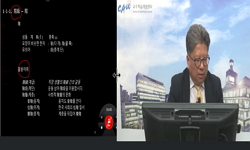한자능력과 학업능력 사이의 상관은 오랫동안 한문교육자뿐만 아니라 인지과학자, 신경과학자 등 많은 연구자들의 주목을 받아왔다. 그러나 한자능력과 學業成就度 사이의 관계를 과학적...
http://chineseinput.net/에서 pinyin(병음)방식으로 중국어를 변환할 수 있습니다.
변환된 중국어를 복사하여 사용하시면 됩니다.
- 中文 을 입력하시려면 zhongwen을 입력하시고 space를누르시면됩니다.
- 北京 을 입력하시려면 beijing을 입력하시고 space를 누르시면 됩니다.
https://www.riss.kr/link?id=A101216599
- 저자
- 발행기관
- 학술지명
- 권호사항
-
발행연도
2015
-
작성언어
Korean
-
주제어
한자 ; 학업성취 ; 언어지능 ; 언어이해력 ; 형태소 인식력 ; 시각적 기술 ; 汉字 ; 学业成就 ; 语言知能 ; 语言理解能力 ; 形态素认知能力 ; 视觉的技術 ; Chinese (Han) characters ; school achievement ; linguistic intelligence ; language comprehension ; morphological awareness ; copying skill
-
KDC
374
-
등재정보
KCI등재
-
자료형태
학술저널
- 발행기관 URL
-
수록면
173-192(20쪽)
- 제공처
-
0
상세조회 -
0
다운로드
부가정보
국문 초록 (Abstract)
본 연구는 고교생을 대상으로 한자능력과 學業成就度의 상관관계를 탐구하였다. 이를 위하여 고교생들의 學業成就와 관련되는 인지능력들을 검사하였다. 우선 言語知能으로서 言語理解力, 어휘력 등을 측정하고, 아울러 單語 認識 能力으로서 形態素 認識力을 검사하고, 한자발음, 한자의미, 한자 활용 등을 측정하는 일반 한자 능력 검사를 실시하였다. 또한 視覺的 技術을 측정하였다. 視覺的 技術은 한자 읽기와 높은 상관이 있는 것으로 알려져 있다.
조사 결과, 고교생의 학업 성취와 가장 높은 상관을 나타낸 것은 形態素 認識力이었고, 이어서 言語知能, 視覺的 技術의 순으로 나타났다. 한자능력은 學業成就와 유의한 상관을 나타내었으나, 形態素 認識力, 어휘력, 視覺的 技術과 비교하였을 때는 설명력이 약한 것으로 나타났다. 이는 한자 능력이 학업성취에 직접 관여하기보다는 형태소 인식력, 시각적 기술 등을 통해 간접적으로 관여되어 있을 가능성을 가리킨다. 본 연구의 결과는 한자어 교육에 있어서의 새로운 방향을 지시하며, 아울러 한자 능력의 검사 방법에 대한 재검토를 요청한다.
한자능력과 학업능력 사이의 상관은 오랫동안 한문교육자뿐만 아니라 인지과학자, 신경과학자 등 많은 연구자들의 주목을 받아왔다. 그러나 한자능력과 學業成就度 사이의 관계를 과학적으로 밝히는 것은 대단히 어려운 일이다.
본 연구는 고교생을 대상으로 한자능력과 學業成就度의 상관관계를 탐구하였다. 이를 위하여 고교생들의 學業成就와 관련되는 인지능력들을 검사하였다. 우선 言語知能으로서 言語理解力, 어휘력 등을 측정하고, 아울러 單語 認識 能力으로서 形態素 認識力을 검사하고, 한자발음, 한자의미, 한자 활용 등을 측정하는 일반 한자 능력 검사를 실시하였다. 또한 視覺的 技術을 측정하였다. 視覺的 技術은 한자 읽기와 높은 상관이 있는 것으로 알려져 있다.
조사 결과, 고교생의 학업 성취와 가장 높은 상관을 나타낸 것은 形態素 認識力이었고, 이어서 言語知能, 視覺的 技術의 순으로 나타났다. 한자능력은 學業成就와 유의한 상관을 나타내었으나, 形態素 認識力, 어휘력, 視覺的 技術과 비교하였을 때는 설명력이 약한 것으로 나타났다. 이는 한자 능력이 학업성취에 직접 관여하기보다는 형태소 인식력, 시각적 기술 등을 통해 간접적으로 관여되어 있을 가능성을 가리킨다. 본 연구의 결과는 한자어 교육에 있어서의 새로운 방향을 지시하며, 아울러 한자 능력의 검사 방법에 대한 재검토를 요청한다.
다국어 초록 (Multilingual Abstract)
We thus attempted to analyse the correlations between the knowledge of Chinese (Han) characters and school achievement in Korean high school students. Five tests were used. We first measured the students’ abilities to pronounce, understand, and use Chinese (Han) characters. The verbal intelligence was also measured with both vocabulary and language comprehension sub-tests from K-WISC-III. We also measured the students’ morphological awareness and their copying skills with difficult Chinese (Han) and Korean characters. The mid-term scores for Korean language, Mathematics, Practical English, and Economics were obtained and used as each student’s school achievement.
The results showed that morphological awareness was the best variable to account for the variance of the students’ school achievements. And then verbal intelligence, especially vocabulary, and copying skills were also found to account for the significant amounts of variance of school achievement. However, the knowledge of Chinese (Han) characters accounted for only a small portion of variance of school achievement. We suggest that the poor explanatory power might be attributed to indirect connections from the knowledge of Chinese (Han) character to school achievement via morphological awareness and visual skills .
The results of the present research indicate a new direction in Chinese (Han) character education, and, at the same time, call for the tests of Chinese (Han) character knowledge using the scientific methods.
The idea that the abilities to read and write Chinese (Han) characters improve school achievement has attracted much attention from a variety of scholars such as Chinese (Han) character educators, cognitive scientists, and neuroscientists. However, li...
The idea that the abilities to read and write Chinese (Han) characters improve school achievement has attracted much attention from a variety of scholars such as Chinese (Han) character educators, cognitive scientists, and neuroscientists. However, little research has addressed the issue using scientific methods in Korea.
We thus attempted to analyse the correlations between the knowledge of Chinese (Han) characters and school achievement in Korean high school students. Five tests were used. We first measured the students’ abilities to pronounce, understand, and use Chinese (Han) characters. The verbal intelligence was also measured with both vocabulary and language comprehension sub-tests from K-WISC-III. We also measured the students’ morphological awareness and their copying skills with difficult Chinese (Han) and Korean characters. The mid-term scores for Korean language, Mathematics, Practical English, and Economics were obtained and used as each student’s school achievement.
The results showed that morphological awareness was the best variable to account for the variance of the students’ school achievements. And then verbal intelligence, especially vocabulary, and copying skills were also found to account for the significant amounts of variance of school achievement. However, the knowledge of Chinese (Han) characters accounted for only a small portion of variance of school achievement. We suggest that the poor explanatory power might be attributed to indirect connections from the knowledge of Chinese (Han) character to school achievement via morphological awareness and visual skills .
The results of the present research indicate a new direction in Chinese (Han) character education, and, at the same time, call for the tests of Chinese (Han) character knowledge using the scientific methods.
동일학술지(권/호) 다른 논문
-
- 한국한자한문교육학회
- 李炳周
- 2015
- KCI등재
-
- 한국한자한문교육학회
- 이군선 ( Goon Seon Lee )
- 2015
- KCI등재
-
한문(漢文) 문법(文法) 학습(學習) 실태(實態) 분석(分析)을 통(通)한 수업(授業) 방안(方案) 모색(摸索)
- 한국한자한문교육학회
- 김경익 ( Kyong-ick Kim )
- 2015
- KCI등재
-
한문과(漢文科) 평가(評價)의 위상(位相)과 연구(硏究) 동향(動向)
- 한국한자한문교육학회
- 김왕규 ( Wang Gyu Kim )
- 2015
- KCI등재





 코리아스칼라
코리아스칼라






